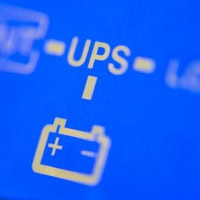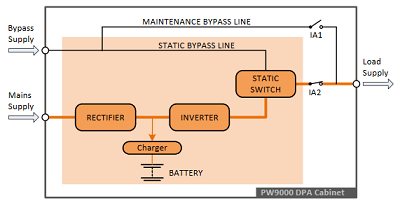Communications capability is vital to the effectiveness and wellbeing of a UPS: While crucially facilitating orderly system shutdowns during extended power failures, it also allows continuous monitoring and pre-emptive maintenance of UPS power systems and batteries, as well as optimised management of the critical load.
In this article, Alan Luscombe, director at KOHLER Uninterruptible Power Ltd., a KOHLER company, looks at the benefits of effective communications strategies to UPS operation, together with the technologies typically used to implement these.
UPS power systems without adequate communications capability is only partially effective, and in some situations, entirely useless. If the UPS power systems cannot warn its critical load of a power blackout likely to exceed the UPS battery autonomy period and give it time to shut down gracefully, then a system crash is merely delayed rather than prevented.
However, communications contribute to UPS power systems performance in other ways as well. For example, indications of current UPS status can be used to trigger pre-emptive UPS maintenance, rectifying faults before they can develop into system failures. In this article, we look at the operational and maintenance benefits that become possible, together with the communications technologies currently used to achieve them.
Keeping it simple – volt-free and serial communications
On some sites, especially if the load is not considered to be critical, implementation simplicity is valued above highly-detailed data. If so, simple volt-free contacts may suffice. These provide ‘True/Not True’ alarms and messages to cover situations such as Mains Failure, Load on Inverter, or Battery Low. Such contacts can be connected to remote – but on site – alarm panels and UPS power systems monitoring systems such as a Remote Status Panel (RSP) or Building Management System (BMS).
These contacts can also trigger network software running on the critical load computers to initiate an orderly system shutdown. Support for this is available within almost all Windows, Mac, Linux and Unix variants. The necessary software may be embedded in the system, or available from the network operating system supplier or UPS power systems supplier.
In any case, the software uses the contact signals, together with timers, to decide if or when a system shutdown should be initiated. If the software is installed on a computer network server, that server can be designated as a master and used to relay UPS alarms to other network devices, which can also be configured to respond appropriately.
If more information is required than volt-free contacts can deliver, an RS-232 serial communications port offers a reasonably simple improvement. It can monitor and exchange analogue data rather than just ‘True/Not True’ signals. For example, a remote RS-232 connected terminal could display:
- Inverter output voltage, frequency, current, kVA and kW
- Bypass voltage, frequency, current, kVA and kW
- Battery voltage, charge/discharge current and remaining battery time
- Statistics regarding mains failures and UPS operation
It is normal practice to monitor critical UPS alarms continuously and in real time, while the operational status can be requested as needed by a system administrator or supervisor. As there is no European standard for UPS RS-232 protocol, each UPS manufacturer offers their own implementation. Additionally, most UPS power systems suppliers offer proprietary software to extract the most useful information from the serial data, although the features offered vary between suppliers.
Such software runs under most operating systems and, as Fig.1 below shows typically offers facilities including:
- A graphical display of UPS status, voltage, current, load, battery voltage, frequency and other parameters
- Configurable responses to certain UPS alarms, such as broadcasts to users
- Scheduled diagnostic checks and data logging
Fig.1: Typical UPS monitoring screen
Other serial interfaces in current use include RS-485 and RS-422 for longer-distance communications. RS-422 is generally favoured as it is full-duplex and minimises problems. Modern UPSs also incorporate USB interfaces to enable real-time UPS monitoring.
Networking and SNMP
As UPS power systems become more complex, distributed over a wide area, or run more critical applications, a more sophisticated, network-based strategy becomes essential. A widely adopted and successful solution is the System Network Management Protocol (SNMP), which is part of the Transmission Control Protocol/Internet Protocol (TCP/IP) suite. It allows a network manager to supervise and control many devices across an enterprise network from a central location. Data can be exchanged between these devices in a mutually-compatible format. This is true even for wide-area networks comprising several remote sites, some possibly unmanned, and distributed over an extensive geographical area.
A UPS with SNMP capability becomes an intelligent device that can for example:
- Log events
- Continuously monitor power quality
- Report on battery status, load and temperature
- Perform self-diagnostics
An SNMP adaptor is a hardware component that connects the UPS system onto the network. Software provided with SNMP adaptors should be compatible with all popular operating systems, and offer features including:
- Remote control and rebooting of UPS-protected devices over the network or Internet
- Protection of information and systems through automatic and graceful shutdown of multiple UPS-protected devices during an extended power failure
- Generation of real-time email, mobile phone or SMS alarm notifications
- SSL and SSH data encryption and authentication capability
- Web pages served automatically in the selected local language
- Activity and UPS alarm logging
An intelligent SNMP-enabled UPS may be able to control its connected devices, for example turning them on or off. This would allow a system manager to isolate sections of the load for security purposes, shut down devices to reduce energy consumption, and manage redundant portions of the UPS system.
Because intelligent UPS power systems condition power, system disruption due to power disturbances can be dramatically reduced. The UPS can log power disturbances, track battery usage, issue alerts of low battery problems and record power level history. Through SNMP, this information is available to managers and supervisors for immediate analysis and to detect potential problems before they cause disruption.
SNMP allows operators to manage the UPS load more efficiently as well as controlling the UPS power system itself, by linking large numbers of UPSs into a network and feeding status data to the central network console.
If required, UPS communications can be integrated with a third-party remote management resource such as KUP’s PowerREPORTER. This package constantly scans its client UPS power systems, automatically detecting any error or alarm messages. In the event of an incident, PowerREPORTER provides status information and details via email to KUP’s service centre, which in turn alerts the field team, allowing them to respond appropriately.
Fig.2: Automatic callout facility with PowerREPORTER
Conclusion
In this article, we have seen the vital role of communications – whether volt-free contact, serial or networked – in not only facilitating graceful system shutdown during a power failure but for UPS monitoring and maintaining the health of the UPS system whilst managing the load that it protects.
For more information on PowerREPORTER remote UPS monitoring please call us on 0800 731 3269 or email us at [email protected]
Article published in January/February 2017 edition of Networks Europe
For up-to-date articles from KUP follow us on our LinkedIn and Twitter pages







